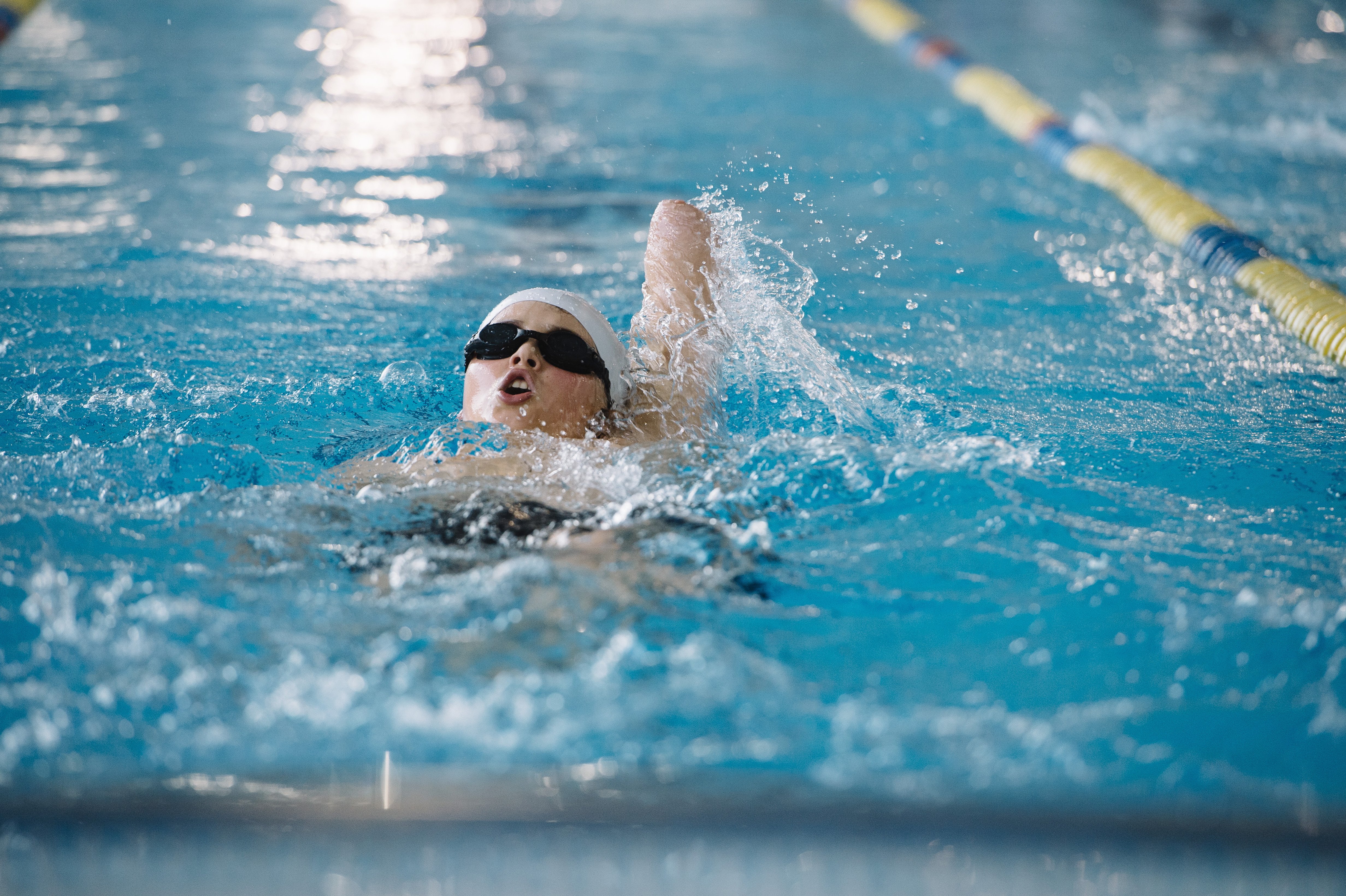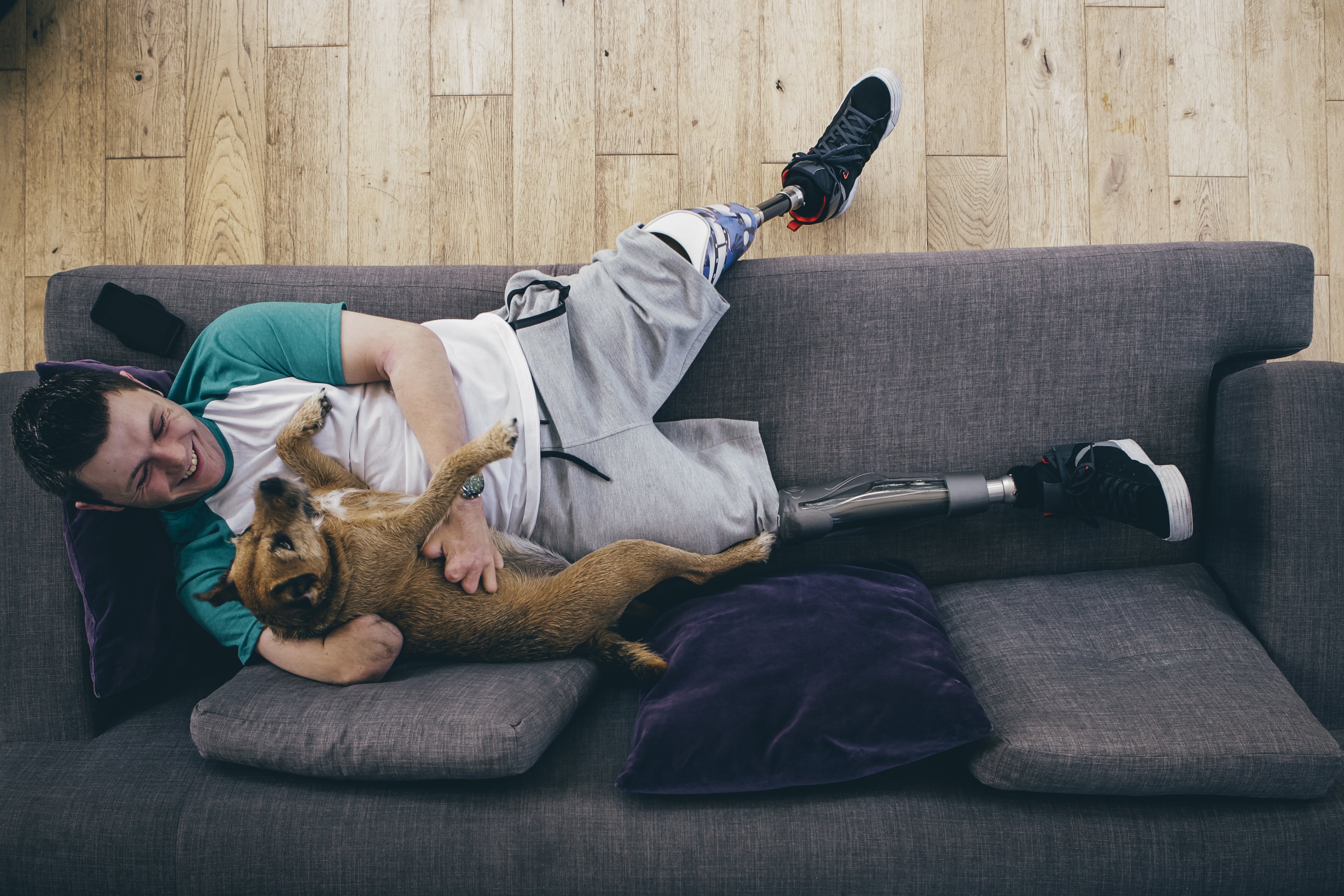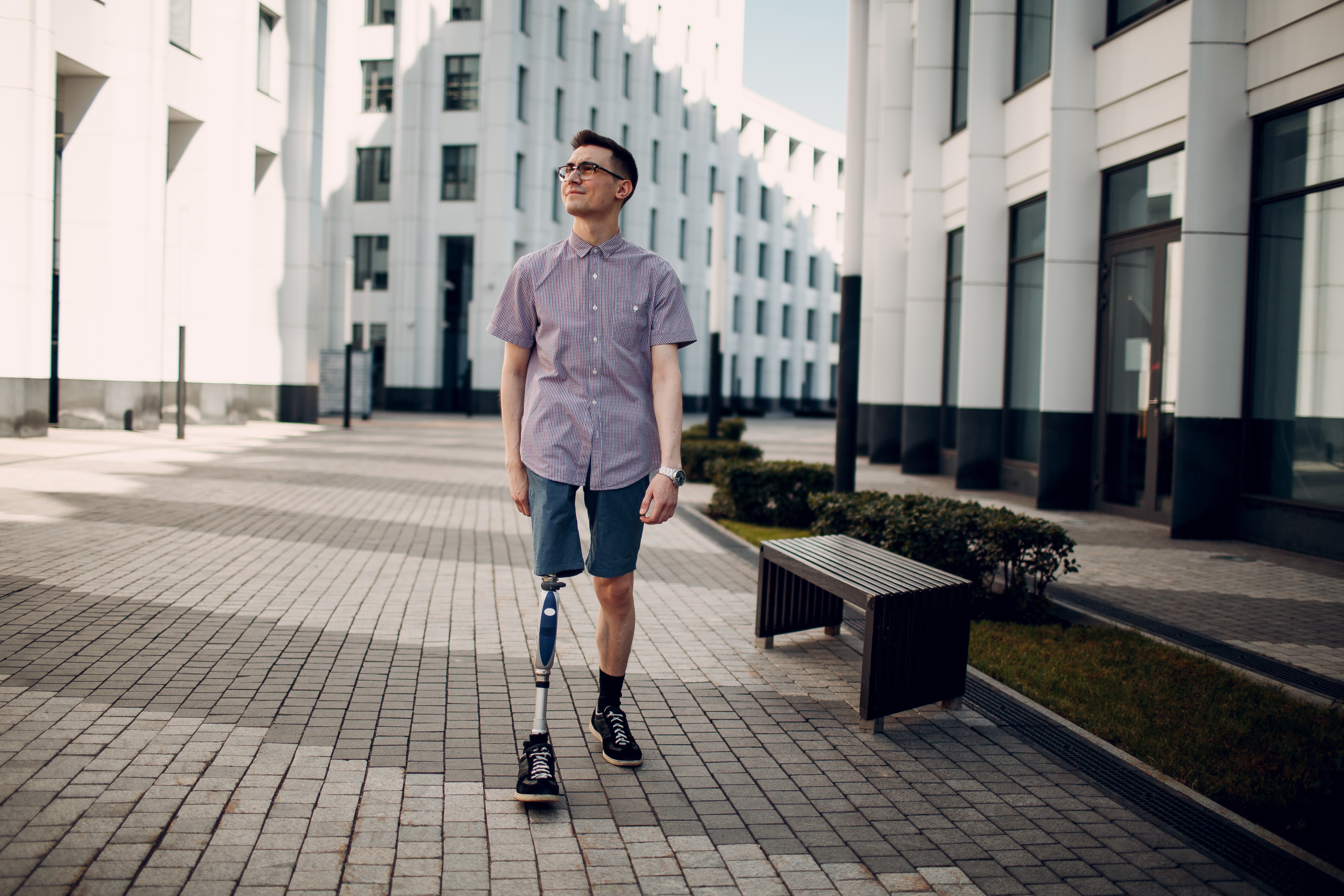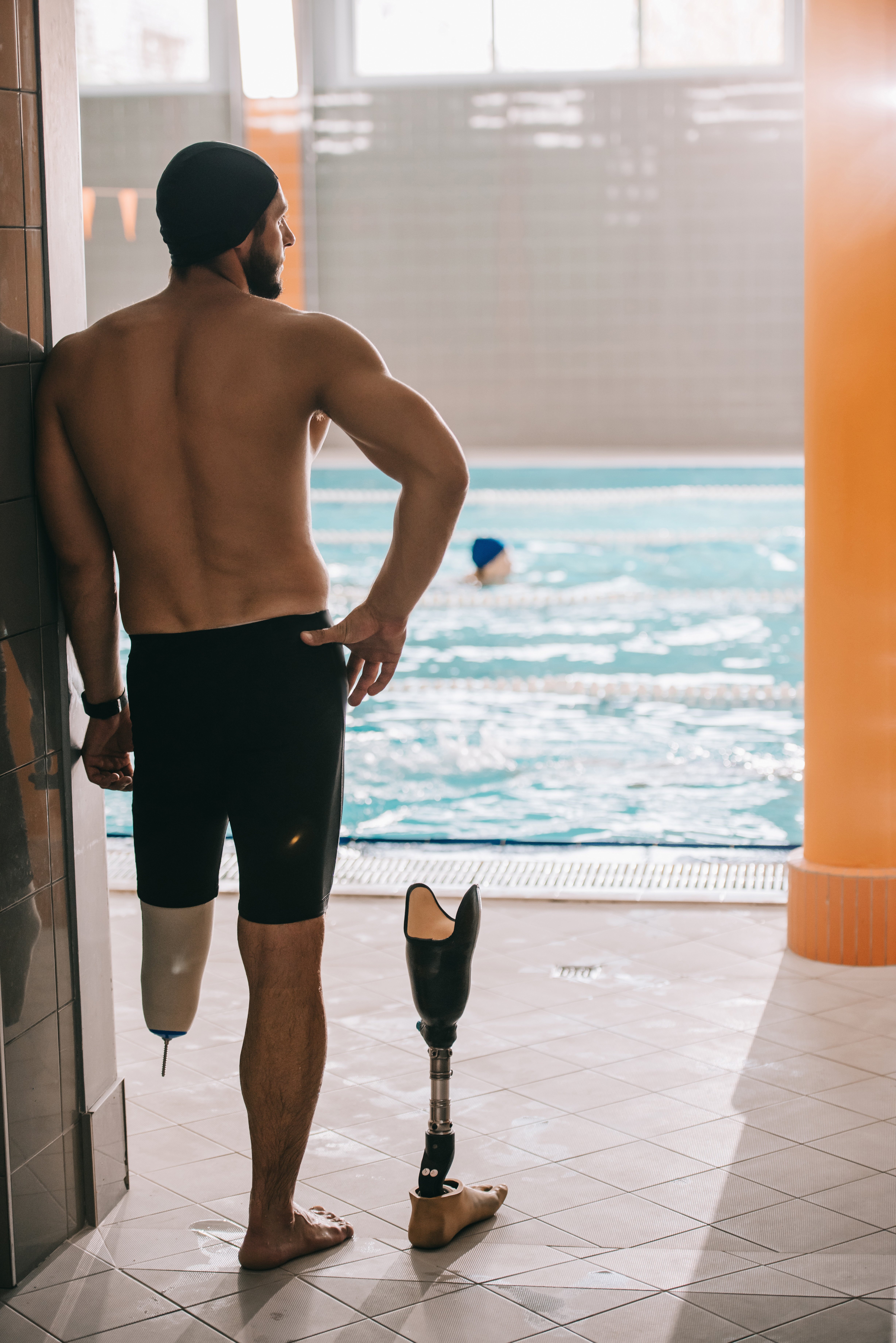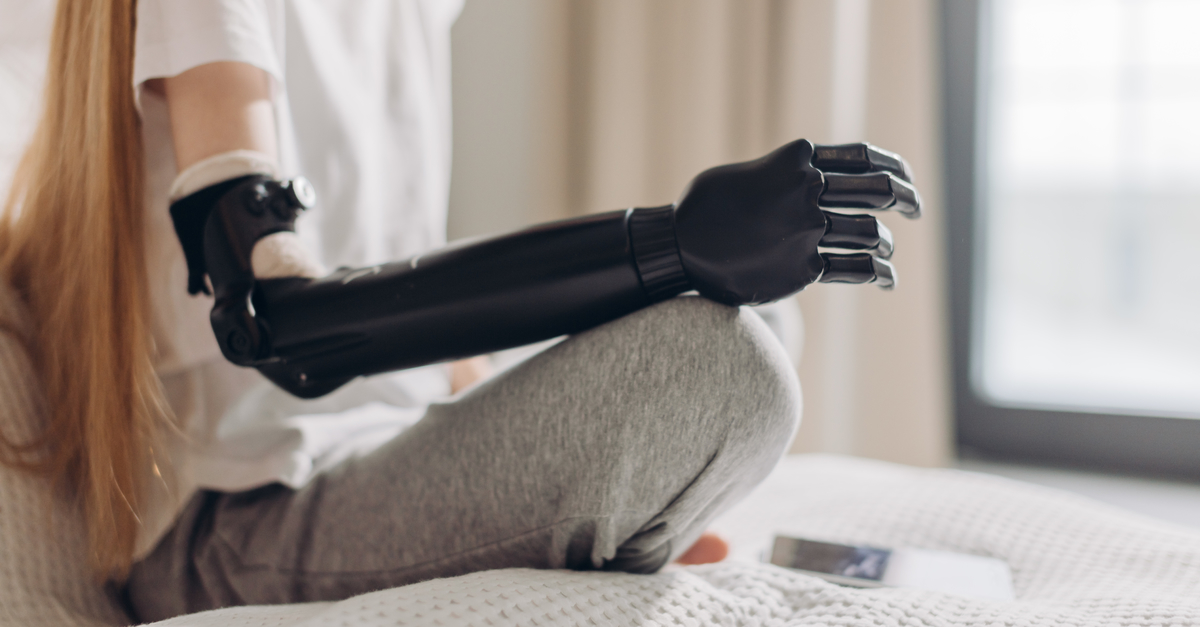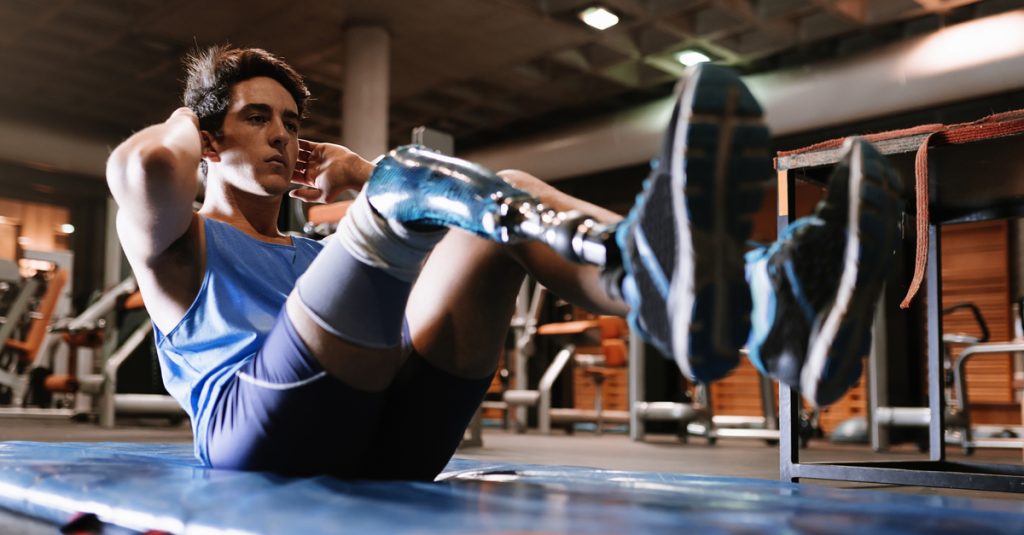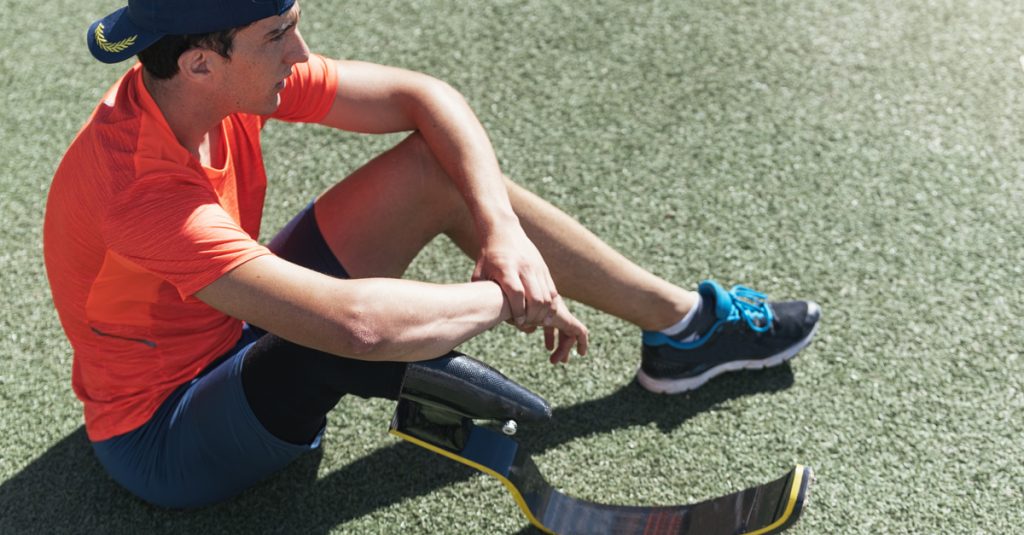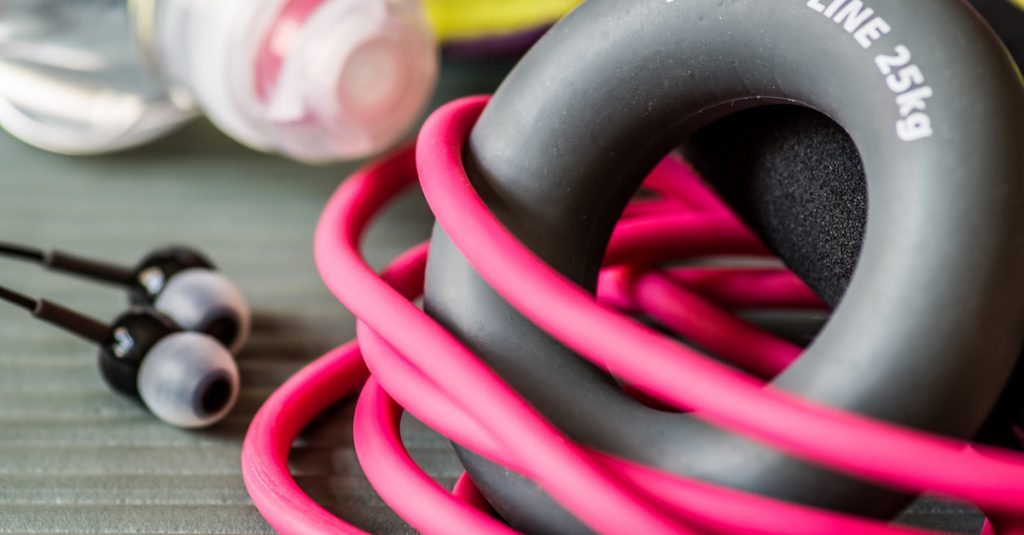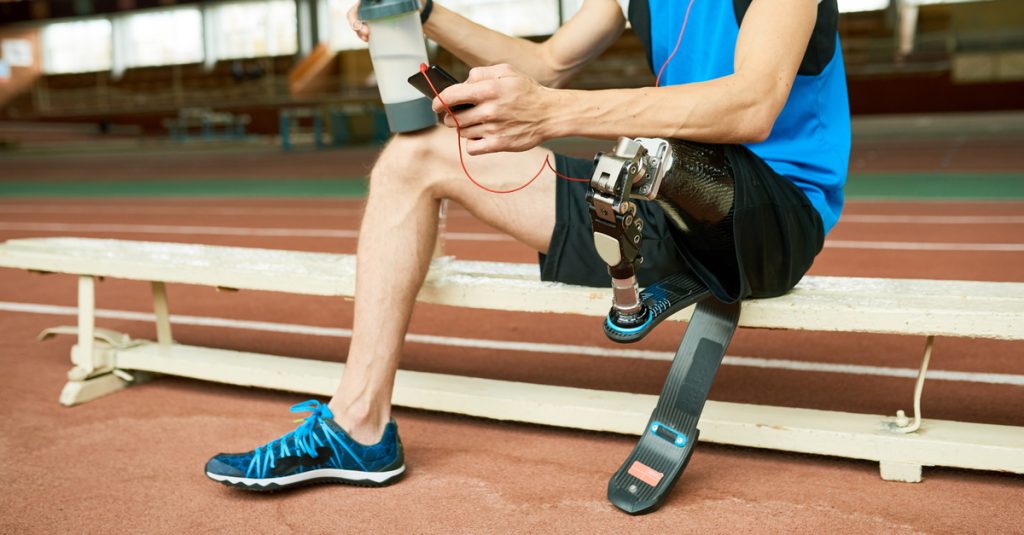Hands play a big role in the functions of our daily lives, communication, and interacting with the world around us. The loss (full or partial) of an arm is a monumental event that will have its challenges—but you don’t have to do it alone.
If you are facing a full or partial arm amputation, the following information will help guide you through issues to consider before and after surgery. Preparing ahead of time will help you know what to expect with rehabilitation, emotional support, prosthetics, and resuming an active lifestyle.
Pre Surgery
For those undergoing an elective amputation, you have the benefit of preparing for your recovery before ever entering the operating room. Use this time to meet with your surgical team and ask to be walked through the procedure. You may want to talk to other amputees about their experience and find a support group to join.
Be sure to consult with a prosthetist ahead of time. It’s okay to be picky. You will work closely together for a year or longer, so make sure they’re a good fit.
Post Surgery, Rehabilitation, and Emotional Support
Despite the research and preparation you do pre-surgery, the changes to your body can be shocking in the early days of recovery.
Following surgery, you will be treated with bandages and compression socks to help heal and shape your residual limb. You will be shown how to care for your limb, wash, dry, and reapply bandages. Expect changes in swelling and shape as you begin rehabilitation.
Rehabilitation will start according to your doctor's instructions. A team consisting of your doctor, occupational and physical therapists, and your prosthetist will work to stretch and strengthen the muscles in your residual limb.
Part of your rehabilitation may include having a counselor assigned to you to help you work through difficult emotions. Remember that you have undergone a major change and it is normal to experience some level of depression. Don’t be ashamed to ask for help. Reach out to support groups and individuals who have experienced limb loss. You don’t have to go through it alone.
Prosthetics
During rehab, you will work closely with your prosthetist to find what fit and function best suits your prosthetic needs. There are options ranging from passive prosthesis (no movement) to state-of-the-art neuroprosthetics (controlled by the brain). You may find you need one prosthesis for daily tasks, and another for specific activities.
Maintain an Active Lifestyle
Getting back into a normal routine after an arm amputation is essential to your overall health and healing. Thanks to advancements in prosthetics, you will find there’s a way to participate in just about any activity. From driving a car to competitive sports, there are solutions to help you stay active and independent.
Undergoing an arm amputation is a major life change and comes with many challenges. Thankfully, there are systems in place for you to overcome obstacles and lead a full life. Preparing yourself ahead of time can help make it a little easier.
Let the experts at BioTech answer your questions and help you prepare for your prosthetic needs. Contact us today for a consultation.
There are more than two million people living with limb loss in the United States, and about 185,000 people have an amputation each year. That’s an estimated 507 people who lose a limb each day.
Chances are, you know or have come in contact with an amputee. You may not be aware what comments or questions can be offensive, or understand what life is really like for them.
Here are a few things amputees want you to understand about their lives.
#1: No Two Experiences Are the Same
No two amputees or people with limb differences are the same. A congenital amputee (the way a person's body was formed in the womb) would have a totally different experience from that of an adult lower limb amputee. Each experience and person is unique.
#2: Different People Use Different Words
Using terms like “disabled” or “differently abled” may seem offensive and patronizing to some, but not to others. In regards to a person’s residual limb (remaining limb), some call it a “stump” and others still refer to an arm or leg as before. When in doubt, ask. And listen to what words the person uses for themselves.
#3: Amputees Are People, Not Curiosities
Questions are normal, but remember to be tactful. Asking details about a person’s limb differences may be a sensitive subject involving trauma. It is normal to notice that a person has a difference, but adjusting how you react to these differences is important.
#4: Amputation Can Improve Quality of Life
Amputation may seem inherently limiting. But for elective amputees, it may have been a choice to restore mobility and quality of life. A person living in chronic pain after an accident or injury may choose amputation as a means of relief.
#5: Assumptions Hurt
Don’t assume the worst. You never know what a person’s story is or what their quality of life is like. Comments like, “I could never do what you have to do,” or, “It must be hard to...” can be offensive. Keep an open mind and remember that different does not equal bad.
#6: Laughter Is Good
It’s ok to laugh with someone if they make a joke about their amputation or limb difference. For some, emotional healing after an amputation includes finding the humor in it.
#7: Prosthetic Devices Are Unique
There is artistry and craftsmanship that goes into making each prosthesis. Lower limb amputees may have a prosthetic device for everyday use, blades for running, or a special foot to use with high heels.
#8: Not All People Choose Prosthetic Devices
Not all people with limb difference find prosthetics useful. To some, it may be more difficult to learn how to operate with a prosthesis than not. This is a matter of personal preference.
#9: Amputees Want Authentic Representation on Screen
Often, amputees are portrayed as a person triumphing over adversity, but in reality they’re usually just living their daily lives like anyone else. Some would like to see more authentic representation, having real amputees cast in roles rather than an actor in costume.
#10: You Play a Role
We all have a part to play in making the world more accessible for those with limb loss and limb difference. Consider your voice and how you can impact change to make the world more accessible for all.
BioTech Limb and Brace has numerous resources and support for the limb loss community. Contact us today to learn more.
Becoming an amputee can have a drastic impact on one's life. It requires change, motivation, and the willingness to adapt. If you have recently undergone an amputation or if you are looking to learn more about life with a prosthesis, keep reading to find out the 5 things amputees wish they had known.
#1: Having Confidence Goes a Long Way
You may be struggling with the fear of others’ opinions, but it’s important to be confident. Any lack of confidence can cause one to succumb to their fears. Instead, try to remain positive and embrace your amputation. Confidence goes a long way, but always remember that it does not happen overnight. Take time to embrace this new way of life and be easy on yourself in the meantime.
#2: People Stare Because They Are Curious
It may feel like people stare at you because you look different and they’re secretly casting judgement, but be assured that most people stare because they are simply curious. Many people have questions but might be too scared or embarrassed to ask. Try to remember that a prosthesis is not the norm, and many people have not seen them before.
#3: Choosing a Supportive Prosthetist Matters
Finding a nice prosthetist is only half of the solution. You need to choose a prosthetist who will listen and try to enhance your experience with a prosthetic. Some prosthetists can be resistant to change and new technologies. Make sure your voice is heard, so you can choose a supportive prosthetist who truly cares.
#4: You Don’t Have to Be Athletic to Be Active
Getting active can be as simple as dancing in your living room or as extreme as running a half marathon. Any activity that gets your blood flowing is going to improve your quality of life and overall well-being.
#5: Always Carry Extra Supplies
Nothing feels worse than being unprepared when you’re out doing something. Carrying extra socks, wipes, and lotions can be life-savers when you’re out and need a little pick-me-up. Sometimes all you need to do is remove your limb, and put it back on. Keeping a wrench on hand may be useful if anything decides to come loose.
The road to recovery is filled with obstacles, but it is not impossible. During this time, try to remain active and think positively. Your journey has not come to a halt—it has only begun.
Looking for a prosthetist who wants to enhance your experience with a prosthesis? Contact BioTech today.
Prosthetic sleeves and liners are essential tools if you use a prosthetic device. They’re easy to apply, provide great suspension, and, if they fit well, will make your prosthetic device feel light and comfortable.
Without proper maintenance, your prosthetic liners and sleeves can become brittle and start to crack. Also, they start to smell if not cleaned properly and regularly, and will eventually fall apart. Here are some essential tips to maintaining your prosthetic tools!
Avoid Animal-Based Skin Care Products
Any products containing animal fats, animal oils, or hydrocarbon oils will eventually break down your gel liners and prosthetic sleeves. Check your soaps, creams, lotions, sunscreens, and any other skin care product you use on your body—and find replacements if you find that they’re animal-based.
Socket Fit
Air pockets or general looseness inside your liner will result in gel delamination. When your liner moves around more than usual, it will eventually break down. You’ll notice discoloration on the outside fabric, and eventually the inside gel will begin to thin out and tear.
Looseness affects prosthetic liners even more when you use a locking system, because excess movement near the bottom of the pin will make the umbrella (device that holds the pin) fall off from the liner.
Cleaning
The purpose of a good cleanser is to remove sweat and grime, with no extra chemicals or ingredients that could irritate your skin. Make sure you get a pH balanced cleanser to avoid irritation. Anything gentle, like a small amount of baby shampoo, can get the job done. When you go to clean your liners, use your hands and wash the gel and fabric until it lathers. When rinsing, make sure no residue is left behind. Avoid scrubbing too hard, because this could damage your liners over time.
Prosthetic Wipes
These are great for keeping your prosthetic device clean on the go! They remove dead skin and prevent dirt and grime from accumulating. They will also keep your prosthetic from smelling! Make sure you find wipes that are pH balanced and alcohol-free so your skin won’t dry out. Avoid anything with bleach—instead, opt for wipes with tea tree oil.
Use a Drying Stand
Whether it’s professionally made or a DIY project, you should be using a drying stand to keep your liners sturdy and shaped correctly. Without them, they can get distorted or misshapen.
Avoid Heat
Being exposed to high temperatures can actually melt the gel in your liners, so avoid heat at all costs!
Making sure these things are taken care of doesn’t take much time but will go a long way in making sure your prosthetic device lasts and serves you longer!
For more advice, information, and support, contact Biotech today!
Rehabilitation after an amputation can feel daunting, but it’s absolutely crucial to adapting to life without a limb. Here’s everything you need to expect immediately following your surgery and onward.
Meet Your Team
Your successful rehabilitation depends on the combined efforts of many people—you aren’t alone. Ideally, you’ll have a large team behind you. This team will include key family members, friends, your physician, your prosthetist and their support staff, your physical therapist, your occupational therapist, and your psychologist. The exact size of your team will depend on your personal preferences, your finances, and many other things.
While the outcome is mainly up to you and your effort, the expertise and guidance of each person on your support time is crucial.
Early Stages
Ideally, you’ll see your physical therapist within the first 24 hours following your surgery. This may seem quick, but you’ve just had a major life change, and you’ll need help doing basic things at the beginning. Your therapist will help you get positioned in bed, move from the bed to your wheelchair and back, balance while standing, use crutches, use your wheelchair, or use your new upper extremity assistive device.
A big part of this early start is pain management. Your physical therapist will teach you how to promote healthy healing in your residual limb and how to wrap it up to reduce swelling. While in the hospital, and long after your release, your physical therapy will consist of dynamic exercises that condition and strengthen your residual limb.
Your therapist will also help you through specific exercises tailored to your amputation. They may design exercises that work your hip, back, abdomen, or knee if you’ve had a lower body amputation. Or they may have you doing exercises to strengthen your upper back, shoulder, upper arm, and elbow if you had an arm amputated.
One of the most important reasons to start physical therapy right away is the psychological advantage it will give you. Spending days or even weeks immobilized can encourage you to only focus on your loss, which can easily cause you to start feeling hopeless, and you may have a hard time finding motivation later. Being able to immediately focus on what you can control will do wonders for your outlook and your attitude towards rehabilitation.
Physical therapy will also give you and your therapist the opportunity to closely monitor your healing residual limb. Even minor scratches or abrasions on it can lead to pain, infection, and significant delays in your recovery progress. Your therapist will teach you the rules of hygiene, like cleaning the socket, determining the best ply of prosthetic sock, managing perspiration, and much more.
Lower Extremity Users
For lower extremity users, the primary focus will be on sitting or lying exercises, and eventually standing exercises aimed at reorienting your center of gravity. Weight shifting exercises between parallel bars will help you learn to displace your center of gravity forward, backward, and sideways. These exercises will eventually phase into practicing bearing weight on your prosthesis and will prepare you for the weight shifting that naturally occurs when you’re walking. Of course, your physical therapist will teach you how to put on and take off your prosthetic device, and you’ll practice that quite a bit.
The next step in your rehabilitation will be gait training. Your therapist will do a lot of hands-on positioning and resistive techniques as you start walking again. Your physical therapist and your prosthetist should be working together throughout this entire process, to monitor your progress. You’ll continue to work on strengthening exercises, and especially on specific daily living activities. This will include things like getting dressed, using the bathroom, standing up and sitting down, carrying things, getting in and out of a car, driving, etc.
Upper Extremity Users
The early stages of physical or occupational therapy for the upper extremity focus on maintaining or increasing the mobility of your joints. Strengthening exercises will also be very important at this stage, as well as pain management. Your physical therapist will employ various methods of helping you with any pain you may be feeling, including ultrasound, massage, electrical neural stimulation, acupressure, acupuncture, and resistive exercise.
Much like lower extremity physical therapy, your therapist will help you practice using your sound hand for daily activities like eating, grooming, using the bathroom, writing, picking up objects, etc. They’ll help you learn to use your teeth to assist with some tasks, as well as other methods of making daily activities easier. Also like lower extremity physical therapy, the first goal of your course will be teaching you to put on and take off your new prosthesis—from then on, the focus will be on using the device. How your training proceeds after this point depends largely on whether you have a body-powered or an externally powered device.
Long Term
It’s important to realize that physical therapy is not just for new amputees or new prosthetic users—for optimum mobility and comfort, you should be evaluated by a physical therapist every year or two for the rest of your life. Your physical therapist can pinpoint problems that you don’t notice, problems that if left untreated can lead to back problems or pain elsewhere in your body. It’s been proven that people who continue going to therapy operate much better with their prosthesis and are better walkers and movers overall. People who don’t continue therapy will see a gradual decline in their abilities.
For expert advice, support, and more information, contact Biotech today and discover your possibilities!
In the field of competition, every successful team has a plan that keeps in mind various contingencies from unexpected injuries to the untimely bounce of the ball, so they can emerge victorious even against the toughest opponents.
For those experiencing the loss of a limb, having a game plan for amputee rehabilitation can usher in the process of a new beginning in life.
Before embarking on a successful journey, there are two primary keys to victory are critical regarding successful amputee rehabilitation.
Amputee Rehabilitation Support Team
No successful game plan can be executed without a team acting as one, and it is no different for those undergoing amputee rehabilitations.
Going through an amputation can be a challenging process physically and emotionally but having a loyal group of supporters can make a big difference. The patient’s support team can include anyone from family, friends, a personal physician, and a prosthetist to a physical therapist.
One of the most crucial components of your support team is the physical therapist.
Across America, just a small number of physical therapists specialize in amputee rehabilitation. This is where the patient’s support group along with the services of local hospitals and therapy clinics can greatly assist the patient in deciding which physical therapist is a great fit for them.
Top Notch Physical Therapy
Just as an athletic team needs talented players to win big, a highly talented and capable physical therapist is essential to championship level amputee rehabilitation.
Although the goal of every physical therapist is to provide the best possible care while doing the least amount of harm and getting the patient to function at full capacity, a highly skilled physical therapist can be the difference maker in elevating the level of care for the patient.
A physical therapist can assist the amputee with various aspects of rehabilitation including getting in and out of bed, using a wheelchair, managing pain and preparing the amputee’s body for the use of a prosthesis.
High quality care from a physical therapist can boost the morale of the amputee and provide an important puzzle piece to coming out victorious in amputee rehabilitation.
BioTech designs and manufactures prosthetic limbs for people suffering from limb loss. We treat every patient with compassion and respect, and work hard to deliver superior service and prosthetic devices that change lives. Recognize your possibilities. Contact us today for more information.
A child’s first prosthesis is a big milestone in their life. There’s a lot that comes with it: learning how to master something that may be difficult at first; the emotional turmoil that may come with having to wear a prosthesis; the response your child will get from others.
Parents can really help their children in these times to better cope with their prosthetic device and learn how to wear one well - both physically and emotionally.
Here are things you should cover with your child to help them adjust to the idea of wearing a prosthesis moving forward.
Teach Them Basic Care
A child can better cope with wearing a prosthesis if they are taught how to care for it. Indeed, learning to care for a prosthetic device can make the child more accepting of it - especially for younger children.
Basic care includes cleaning the liner, when and where to remove the prosthesis, how to keep the device away from water, sunscreen, bug spray, and other substances that may harm it, and the importance of resting their residual limb as needed.
For older children, you can also teach them sock management, which helps them get more acquainted with the routine they’ll develop to care for the device.
Talk Honestly With Them
A lot of honest conversations are necessary if your child is going to adjust in a healthy way.
The younger the child, the more accepting they will generally be toward the device. Very young children, such as toddlers, may be more curious than anything. You should still speak only positively about the device to them, and don’t treat them as different. They will, after all, follow your lead with how to deal with the device just like they do on everything else.
For school-age children, how other children respond to the device will be a big concern. You can’t control what other kids say or do, but you can help your child deal with all types of responses, and maintain positive self-esteem in the process. Let them know that other kids may not approve, but that speaks more to their character than the character of your child.
For teens, body image issues will usually emerge. Speak honestly about them and the insecurity they may feel. Let them vent their concerns, and listen to them without trying to change their mind. Help them come to terms with the prosthesis as a new part of their lifestyle and positively reinforce them at all times.
Get Them In Touch with Others in the Limb Loss Community
Community is such an important part of adapting to any major life change, such as limb loss.
There are others out there just like your child who have gone through a wide gamut of experiences. Their insight - and friendship - will be invaluable to your child. It can be something as simple as letting your toddler or young child play with other amputees. For older children, getting them in touch with peers or older mentors will be a major boon.
Life isn’t over when you lose a limb, and that’s a key message you’ll need to impart to your child. Follow these steps and your child will be better for it.
BioTech designs and manufactures prosthetic devices for people suffering from limb loss. We treat every patient with compassion and respect, and work hard to deliver superior service and prosthetic devices that change lives. Recognize your possibilities. Contact us today for more information.
We’re in the thick of sports season, and from now through the end of spring, our kids will be hitting the fields and courts in full force.
If one of your children wears a prosthesis, playing sports brings additional challenges beyond the typical ones facing amputees with an artificial limb. But with a few tips, your athlete can take care of his or her prosthesis and perform like a champ.
Keep the Prosthesis Clean and Dry
Sports and moisture have a long relationship. Sometimes you’re caught out in the open on the field during a downpour. And no matter what the weather, playing sports always delivers another type of moisture: sweat.
It’s important that your child keep their prosthesis clean and dry. You don’t want bacteria to spread, and you want the integrity of the prosthesis and everything that goes with it to stay strong.
Keep the external surfaces of the prosthesis dry. Be sure to clean the inner components, like socks and liners, after every event. Use warm water and soap, and finish by spraying it down with an alcohol-based cleaner.
If your child gets into the habit of cleaning his or her prosthesis after practice, exercise, or a game, it’ll be a lot easier to care for the artificial limb.
Inspect the Prosthesis after Every Outing
Sports can be rough. A prosthesis is vulnerable to sudden contact as well as the usual wear and tear of being worn, which is accelerated during a rough-and-tumble event.
Make sure your child inspects their prosthesis after every practice or game. Look for loose or warped components. Be vigilant for any motor function that appears sluggish, such as if a joint isn’t allowing full movement. Check for cracks, too, and listen carefully for any unusual noise.
If something abnormal appears, tell your prosthetist so it can be checked out and repaired if necessary.
Care for the Residual Limb
Caring for a prosthesis doesn’t extend to just the device itself; it also means taking care of the residual limb.
Playing sports puts a lot of pressure on the residual limb and causes friction and contact between it and the prosthesis in new ways beyond what you get just by walking. This friction can cause irritation that can easily result in sores and blisters if you’re not careful.
Talk to your prosthetist about lotions and gels that may be appropriate to reduce this friction. And wash the residual limb with antibacterial soap after every session or game. You don’t want your athlete to get an infection.
Follow these tips and your child will be playing like a champion all throughout the season.
BioTech designs and manufactures prosthetic limbs for people suffering from limb loss. We treat every patient with compassion and respect, and work hard to deliver superior service and prosthetic devices that change lives. Recognize your possibilities. Contact us today for more information.
Double leg amputees often feel like they can’t live a normal life after their surgeries.
But with today’s technology, these amputees can live a full life - which includes exercising.
Exercising has a ton of benefits for amputees. Some of these benefits - a stronger heart, more energy, a higher metabolism - are the same for everybody. But for amputees, it’s also very important to build up muscular strength in your residual limbs and core to help you move around normally.
Here are two ways for double leg amputees to build up strength and increase mobility - while also dealing with pain and other negative emotions.
Use Resistance Bands to Get Started
You don’t have to jump right into a full-scale workout to start seeing progress.
If you’re a beginner, start with resistance bands. Begin with one leg and alternate with the other as you use the resistance bands to steadily push and pull on your leg muscles, which will strengthen them.
Place more attention on your weaker limb, because it’ll need more exercise to get it to the level of your stronger limb.
This PDF from the Amputee Coalition provides examples of exercises you can do with a resistance band. Even the exercises that don’t use bands can easily be turned into resistance band exercises.
Resistance bands aren’t just for beginners, though; you can get a good workout by using progressively stronger bands as you work your way up.
Try Yoga as a Way to Stay Fit and Focused
Yoga is a great form of exercise that has a lot of benefits for the body - and mind. Doing yoga can help you feel more relaxed and focused while also developing your body - and it’s something you can do, even with double-leg amputation.
One yoga provider created a handy PDF for how leg amputees can do yoga to build up their bodies.
You can also use yoga as a form of pain management. Studies have shown that doing yoga strengthens the size of the insula and the prefrontal lobe in your brain, which creates a strong connection between emotions and cognitive thoughts. This means that as you focus your mind during yoga, you’re actually helping the brain become less sensitive to pain and the emotions that come with it.
BioTech designs and manufactures prosthetic limbs for people suffering from limb loss. We treat every patient with compassion and respect, and work hard to deliver superior service and prosthetic devices that change lives. Recognize your possibilities. Contact us today for more information.
If you’re new to limb loss, you probably have a lot of questions, concerns, uncertainties, and doubts. That’s normal - it’s a tough thing to get used to, one that’ll take time and effort.
We’ve worked with countless patients who have come to us after limb loss frustrated, dejected, and confused. Over the years, we’ve amassed a lot of knowledge and guidance that has helped our patients make the big adjustment and go on to live normal lives.
Here are four tips that can help you move forward, both practically and mentally.
How Do I Choose a Prosthetic Provider?
Your prosthetic device will be one of the most important things to helping you recover and get back to normal. It has to fit right, function well, and be a good match for you. The same goes for the people who make it.
A prosthetic provider, ideally, is someone who makes you feel comfortable and at ease. You’ll need to build a relationship with your prosthetist, so it makes sense to look for a place where you feel at home.
You’ll also want the best technology and the best outcomes. Ask about their devices and how they make them. Talk to previous and current patients to learn from their experiences.
Your prosthesis won’t be a good fit unless your prosthetist is a good fit.
Adapting to Wearing a Prosthesis
A lot of our patients have difficulty with envisioning how it’ll be to wear a prosthesis. It can be overwhelming, but in reality, adapting is easier than you think, with the right guidance.
One issue that comes up involves pain and discomfort. Our patients frequently ask us if wearing a prosthesis will hurt. The answer is simple: no, it shouldn’t, not if it’s designed the right way! Your body will change and adjust over time, and we’ll have to adjust your device to match, but you shouldn’t feel pain when wearing your prosthesis.
You may need rehab or physical therapy to get used to your prosthesis, especially if it’s an artificial leg, but practice makes perfect. All you have to do is work with your prosthetist and follow his or her instructions and keep at it. You will get used to it with a bit of time and patience.
There are also exercises and training you can do to strengthen your body and practice the mechanics of moving around with your prosthesis that can really help.
Coping with Phantom Limb Pain
As an amputee, you may experience phantom limb pain, which is pain or other sensations coming from where the brain thinks your limb used to be. Even though the limb isn’t there, the brain still processes signals from the body that it often interprets as pain.
Phantom limb pain can range from uncomfortable to very unpleasant. There’s no way to predict how severe it will be or when it will occur. Sometimes it lasts for a few seconds, other times it lasts for significantly longer.
Fortunately, you can treat it. There are ways to help patients cope with phantom limb pain that include everything from deep brain stimulation to non-opiate analgesics for pain management.
Read this post on phantom limb pain to learn more about these methods and what you can do.
Adjusting Is All About Learning
We won’t tell you that as an amputee, you can do anything you put your mind to, just like a person with all of his limbs. That’s not true - you will have to adjust, and there will be things that are more difficult for an amputee to do.
But that’s okay, because as you get practice and experience, you can learn ways to do just about anything you want.
Living after limb loss is about finding ways to do things you want to do with whatever works, while understanding that you don’t have to do things like you used to be able to do. It’s healthy to say to yourself, “This will be hard at times and I’m going to have to be a bit creative, but I can figure it out.”
Whether it’s getting in and out of the shower or carrying a load in your arms while walking on your prosthetic leg, you’ll eventually develop systems and habits to function and get around. You’ll train your brain and your body at the same time, and you’ll learn - and with learning comes a more normal life.
Don’t think you have to be the same as a “normal” person. You just have to be you and do things your way. Take pride in being different and in solving puzzles that other people don’t have to face. You’ll feel a sense of accomplishment that other people will never understand.
Life doesn’t end at limb loss - it’s just beginning. Talk to us about getting a prosthetic device and taking the first steps forward in the newest part of your journey.
